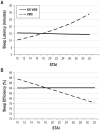Relationships between menopausal and mood symptoms and EEG sleep measures in a multi-ethnic sample of middle-aged women: the SWAN sleep study
- PMID: 21886360
- PMCID: PMC3157664
- DOI: 10.5665/SLEEP.1244
Relationships between menopausal and mood symptoms and EEG sleep measures in a multi-ethnic sample of middle-aged women: the SWAN sleep study
Abstract
Study objectives: Examine associations of vasomotor and mood symptoms with visually scored and computer-generated measures of EEG sleep.
Design: Cross-sectional analysis.
Setting: Community-based in-home polysomnography (PSG).
Participants: 343 African American, Caucasian, and Chinese women; ages 48-58 years; pre-, peri- or post-menopausal; participating in the Study of Women's Health Across the Nation Sleep Study (SWAN Sleep Study).
Interventions: None.
Measurements and results: Measures included PSG-assessed sleep duration, continuity, and architecture, delta sleep ratio (DSR) computed from automated counts of delta wave activity, daily diary-assessed vasomotor symptoms (VMS), questionnaires to collect mood (depression, anxiety) symptoms, medication, and lifestyle information, and menopausal status using bleeding criteria. Sleep outcomes were modeled using linear regression. Nocturnal VMS were associated with longer sleep time. Higher anxiety symptom scores were associated with longer sleep latency and lower sleep efficiency, but only in women reporting nocturnal VMS. Contrary to expectations, VMS and mood symptoms were unrelated to either DSR or REM latency.
Conclusions: Vasomotor symptoms moderated associations of anxiety with EEG sleep measures of sleep latency and sleep efficiency and was associated with longer sleep duration in this multi-ethnic sample of midlife women.
Keywords: Anxiety; REM latency; REM sleep; delta (slow wave) sleep; delta sleep ratio; depressive symptoms; menopausal status; race/ethnicity; sleep continuity; vasomotor symptoms.
Figures

Similar articles
-
Is there a menopausal syndrome? Menopausal status and symptoms across racial/ethnic groups.Soc Sci Med. 2001 Feb;52(3):345-56. doi: 10.1016/s0277-9536(00)00147-7. Soc Sci Med. 2001. PMID: 11330770
-
The role of sleep difficulties in the vasomotor menopausal symptoms and depressed mood relationships: an international pooled analysis of eight studies in the InterLACE consortium.Psychol Med. 2018 Nov;48(15):2550-2561. doi: 10.1017/S0033291718000168. Epub 2018 Feb 12. Psychol Med. 2018. PMID: 29429422 Free PMC article.
-
Sleep is associated with the metabolic syndrome in a multi-ethnic cohort of midlife women: the SWAN Sleep Study.Sleep. 2012 Jun 1;35(6):783-90. doi: 10.5665/sleep.1874. Sleep. 2012. PMID: 22654197 Free PMC article.
-
Vasomotor Symptoms Across the Menopause Transition: Differences Among Women.Obstet Gynecol Clin North Am. 2018 Dec;45(4):629-640. doi: 10.1016/j.ogc.2018.07.005. Epub 2018 Oct 25. Obstet Gynecol Clin North Am. 2018. PMID: 30401547 Free PMC article. Review.
-
Sleep and Sleep Disorders in the Menopausal Transition.Sleep Med Clin. 2018 Sep;13(3):443-456. doi: 10.1016/j.jsmc.2018.04.011. Sleep Med Clin. 2018. PMID: 30098758 Free PMC article. Review.
Cited by
-
Epidemiology of the symptoms of menopause - an intercontinental review.Prz Menopauzalny. 2014 Jun;13(3):203-11. doi: 10.5114/pm.2014.43827. Epub 2014 Jun 30. Prz Menopauzalny. 2014. PMID: 26327856 Free PMC article. Review.
-
Analyses of Menopause and Its Related Symptoms on Sleep Quality Using a Novel Wearable Sheet-Type Frontal Electroencephalography Sensor, Haru-1.Womens Health Rep (New Rochelle). 2025 Apr 10;6(1):393-402. doi: 10.1089/whr.2025.0007. eCollection 2025. Womens Health Rep (New Rochelle). 2025. PMID: 40308360 Free PMC article.
-
Sleep Disturbances in Midlife Women at the Cusp of the Menopausal Transition.J Clin Sleep Med. 2018 Jul 15;14(7):1127-1133. doi: 10.5664/jcsm.7208. J Clin Sleep Med. 2018. PMID: 29991421 Free PMC article.
-
Validation of MotionWatch8 Actigraphy Against Polysomnography in Menopausal Women Under Warm Conditions.Sensors (Basel). 2025 May 12;25(10):3040. doi: 10.3390/s25103040. Sensors (Basel). 2025. PMID: 40431835 Free PMC article.
-
Sleep Self-Report and Actigraphy Measures in Healthy Midlife Women: Validity of the Pittsburgh Sleep Quality Index.J Womens Health (Larchmt). 2022 Jul;31(7):965-973. doi: 10.1089/jwh.2021.0328. Epub 2022 Feb 28. J Womens Health (Larchmt). 2022. PMID: 35230171 Free PMC article.
References
-
- McKinlay SM, Brambilla DJ, Posner J. The normal menopause transition. Maturitas. 1992;14:103–15. - PubMed
-
- Cohen LS, Soares CN, Vitonis AF, et al. Risk for new onset of depression during the menopausal transition: The Harvard Study of Moods and Cycles. Arch Gen Psychiatry. 2006;63:385–90. - PubMed
-
- Freeman EW, Sammel MD, Liu L, et al. Hormones and menopausal status as predictors of depression in women in transition to menopause. Arch Gen Psychiatry. 2004;61:62–70. - PubMed
Publication types
MeSH terms
Grants and funding
- AG012553/AG/NIA NIH HHS/United States
- UL1 RR024153/RR/NCRR NIH HHS/United States
- AG019363/AG/NIA NIH HHS/United States
- R01 AG019361/AG/NIA NIH HHS/United States
- AG012539/AG/NIA NIH HHS/United States
- AG012531/AG/NIA NIH HHS/United States
- U01 AG012495/AG/NIA NIH HHS/United States
- U01 AG012505/AG/NIA NIH HHS/United States
- RR024153/RR/NCRR NIH HHS/United States
- AG012535/AG/NIA NIH HHS/United States
- AG012546/AG/NIA NIH HHS/United States
- NR004061/NR/NINR NIH HHS/United States
- U01 AG012554/AG/NIA NIH HHS/United States
- AG019362/AG/NIA NIH HHS/United States
- R01 AG019362/AG/NIA NIH HHS/United States
- U01 AG012535/AG/NIA NIH HHS/United States
- U01 AG012553/AG/NIA NIH HHS/United States
- U01 NR004061/NR/NINR NIH HHS/United States
- U01 AG012539/AG/NIA NIH HHS/United States
- AG012495/AG/NIA NIH HHS/United States
- AG019361/AG/NIA NIH HHS/United States
- U01 AG012546/AG/NIA NIH HHS/United States
- U01 AG012531/AG/NIA NIH HHS/United States
- R01 AG019363/AG/NIA NIH HHS/United States
- AG012505/AG/NIA NIH HHS/United States
- AG019360/AG/NIA NIH HHS/United States
- R01 AG019360/AG/NIA NIH HHS/United States
LinkOut - more resources
Full Text Sources
Medical

